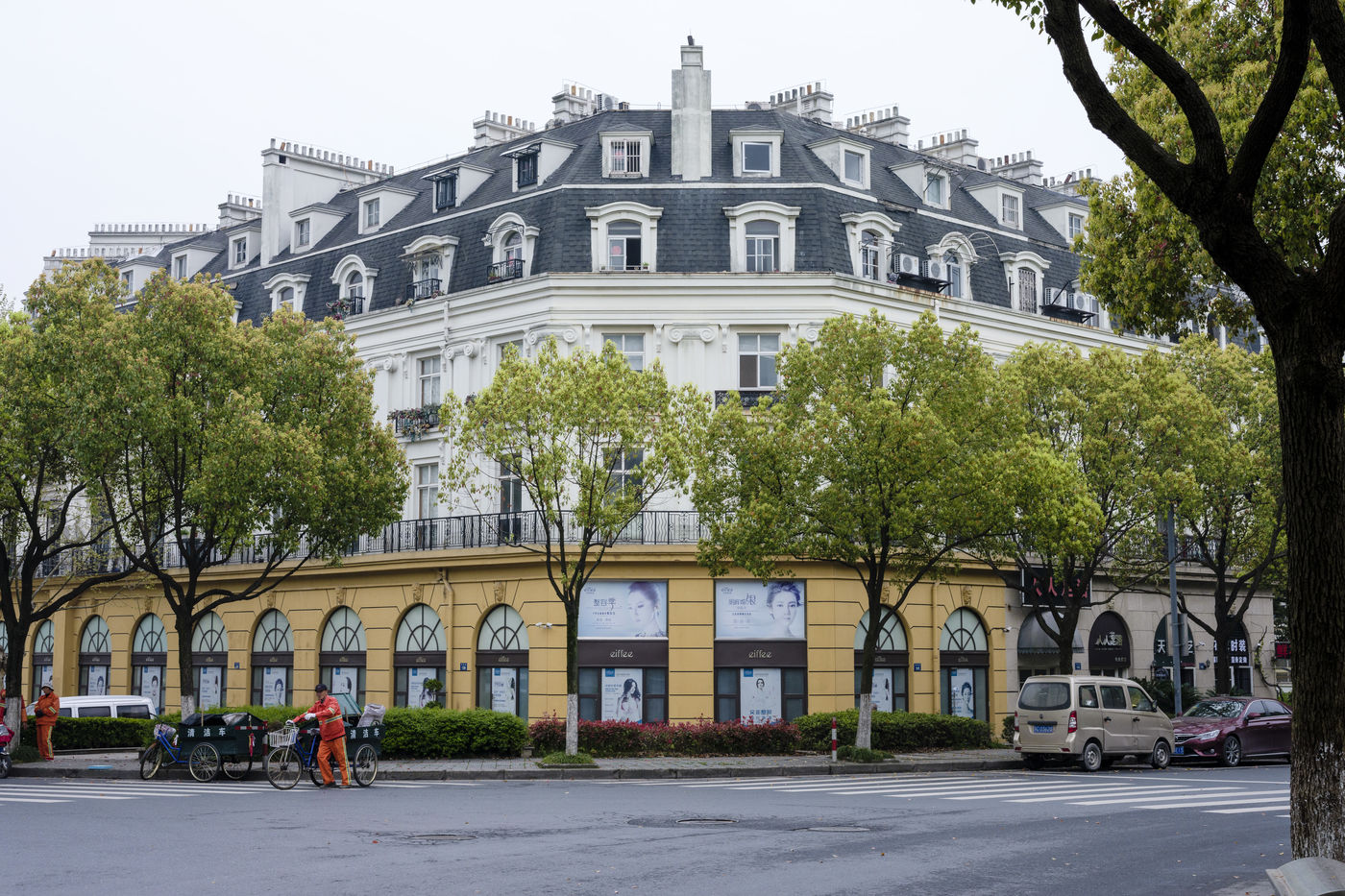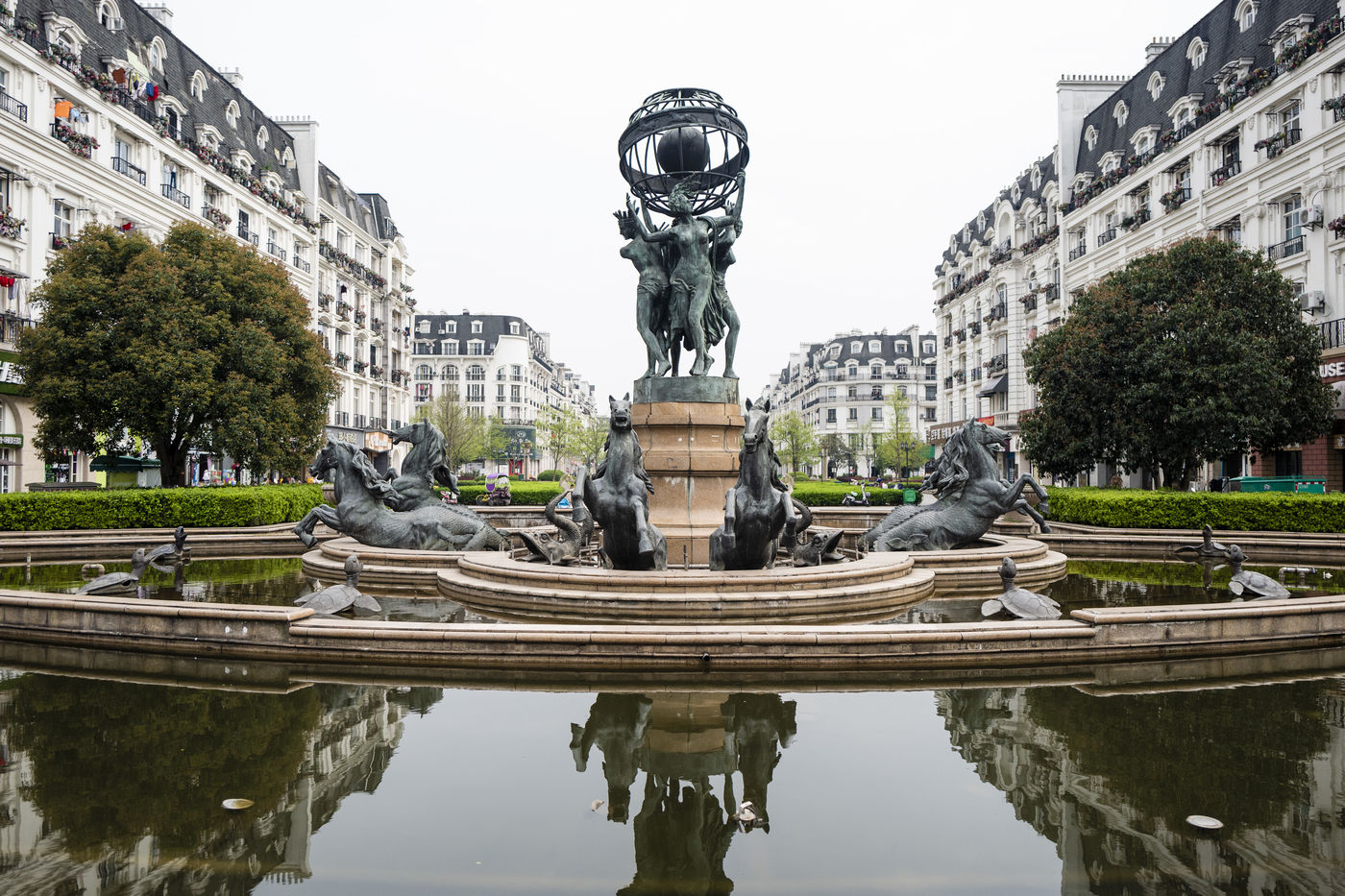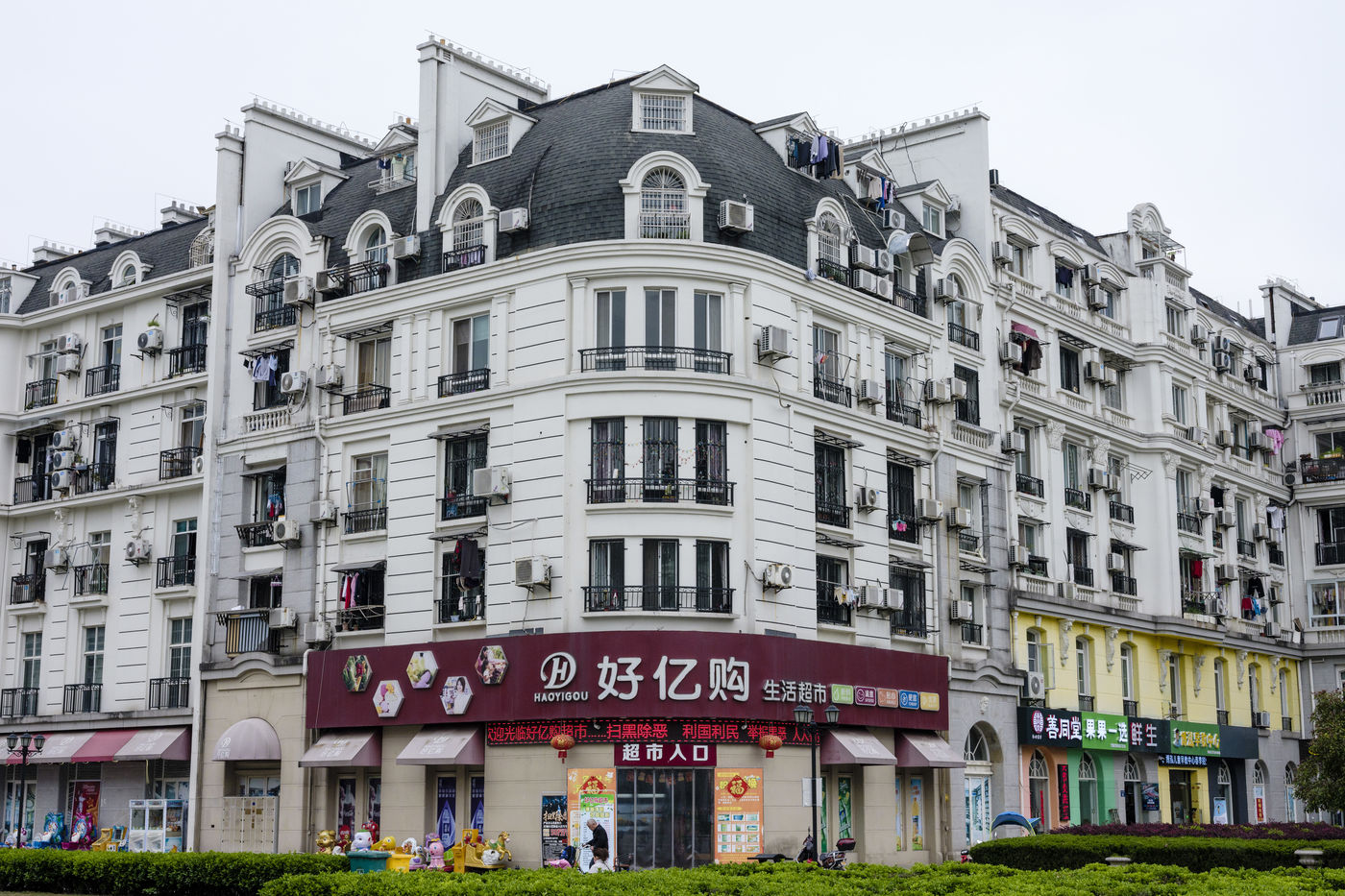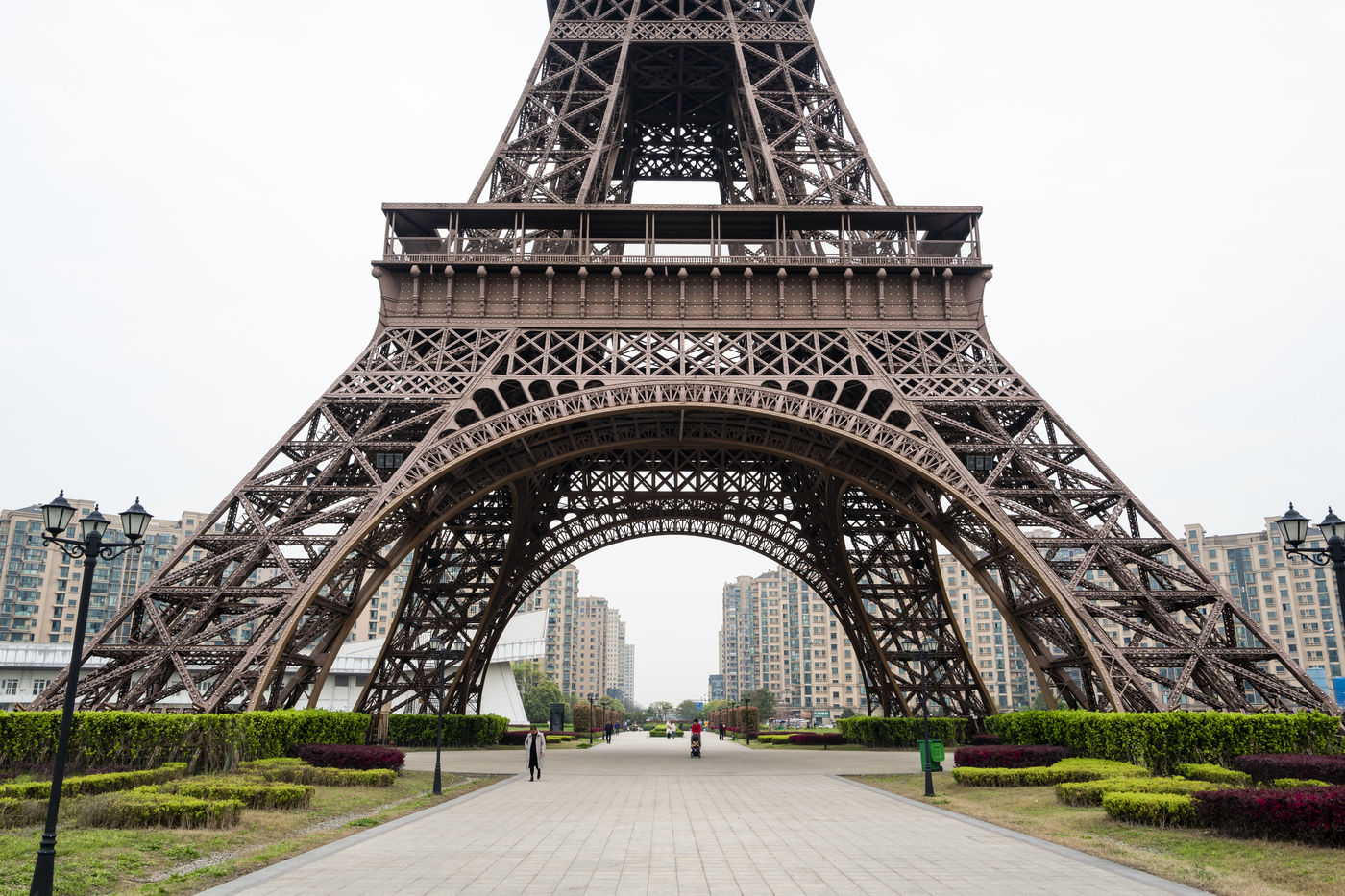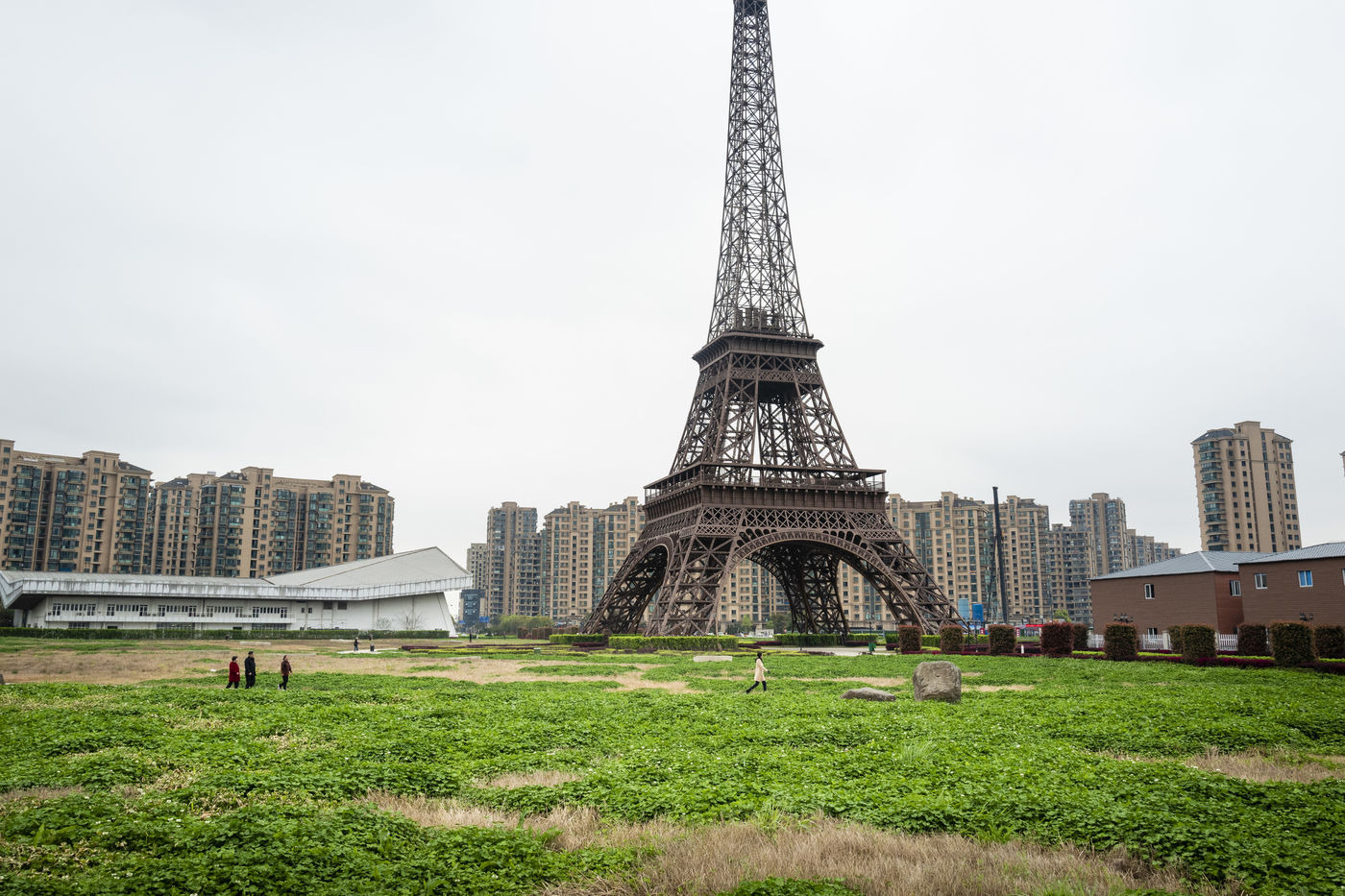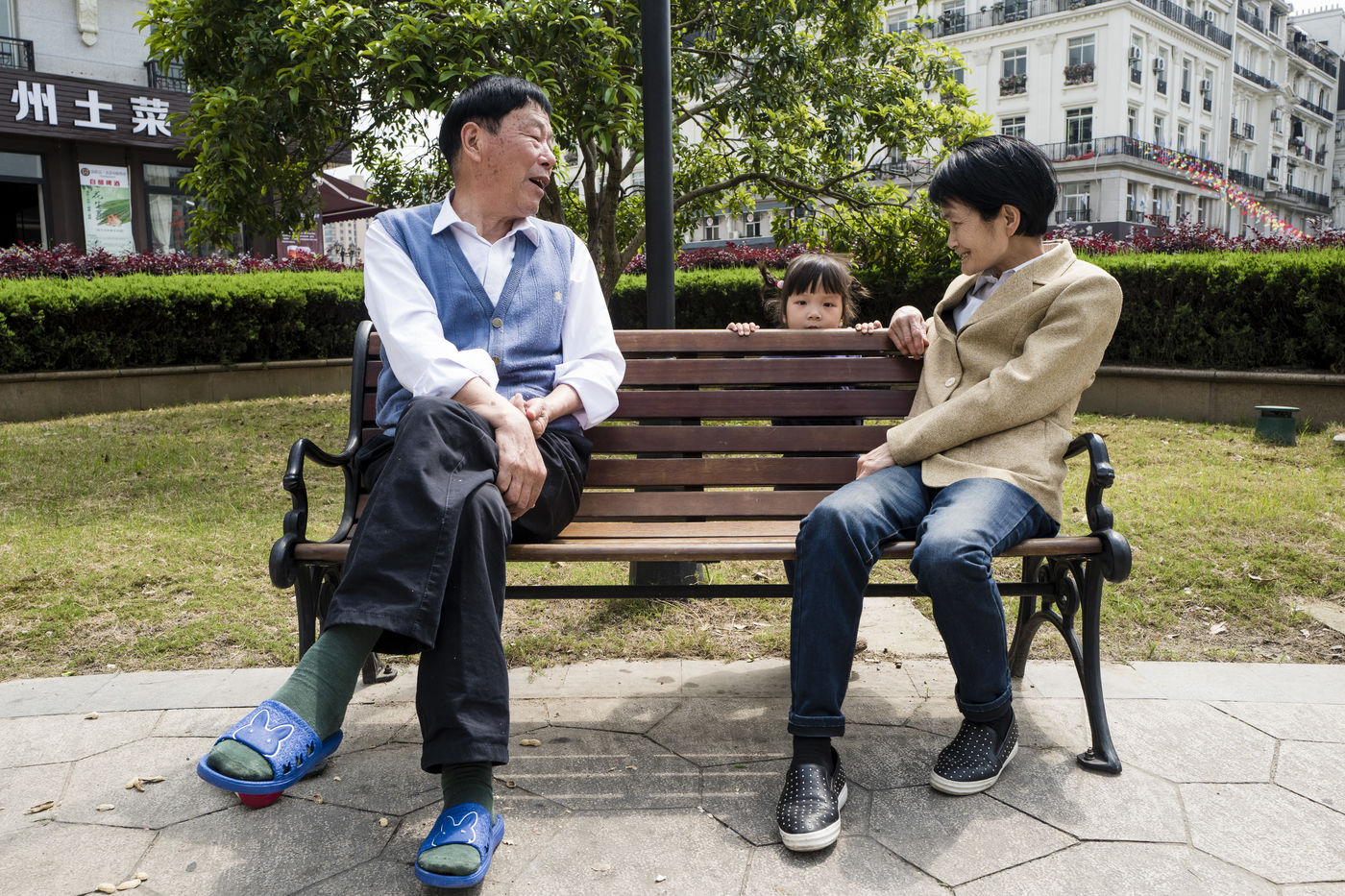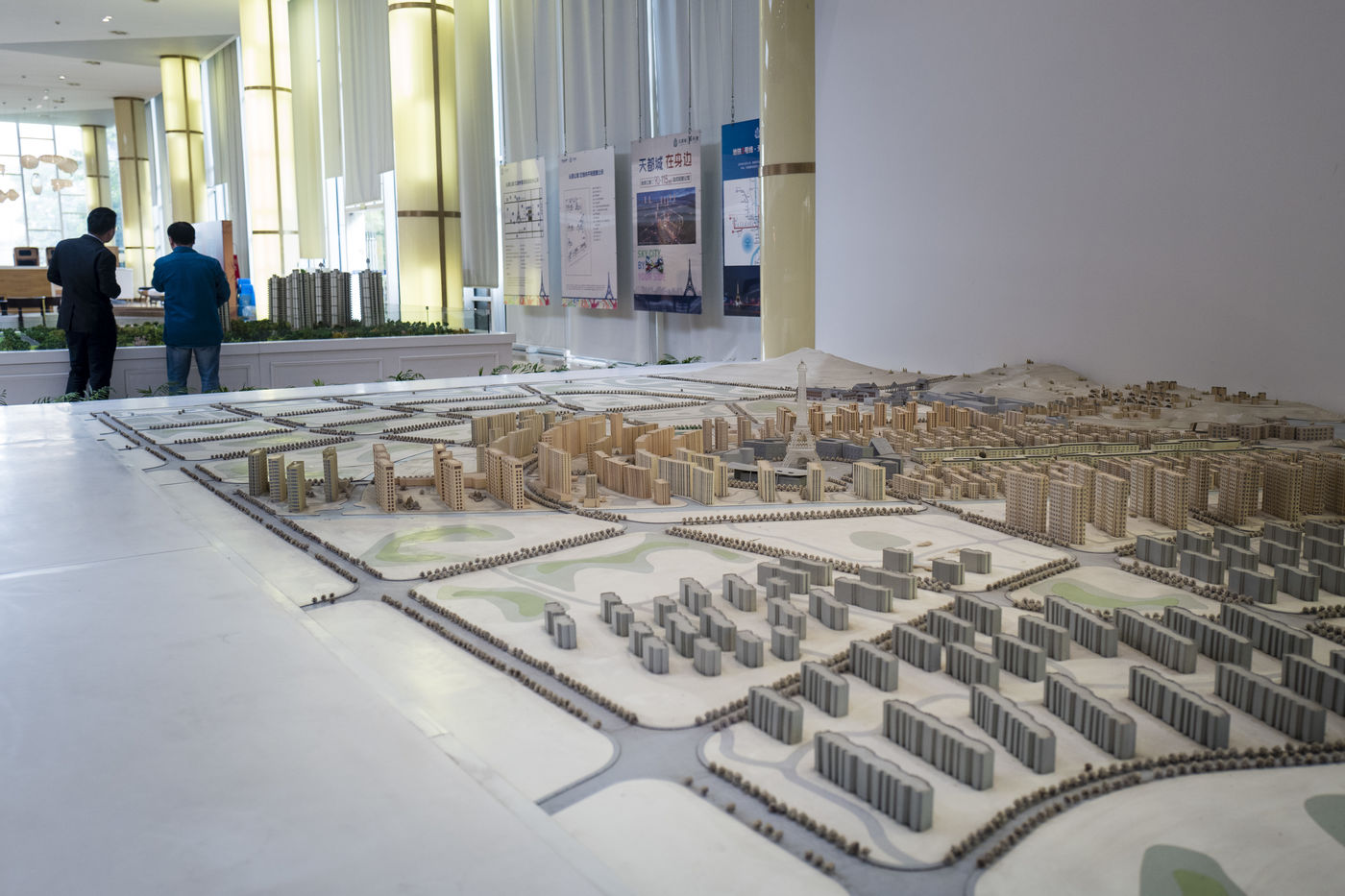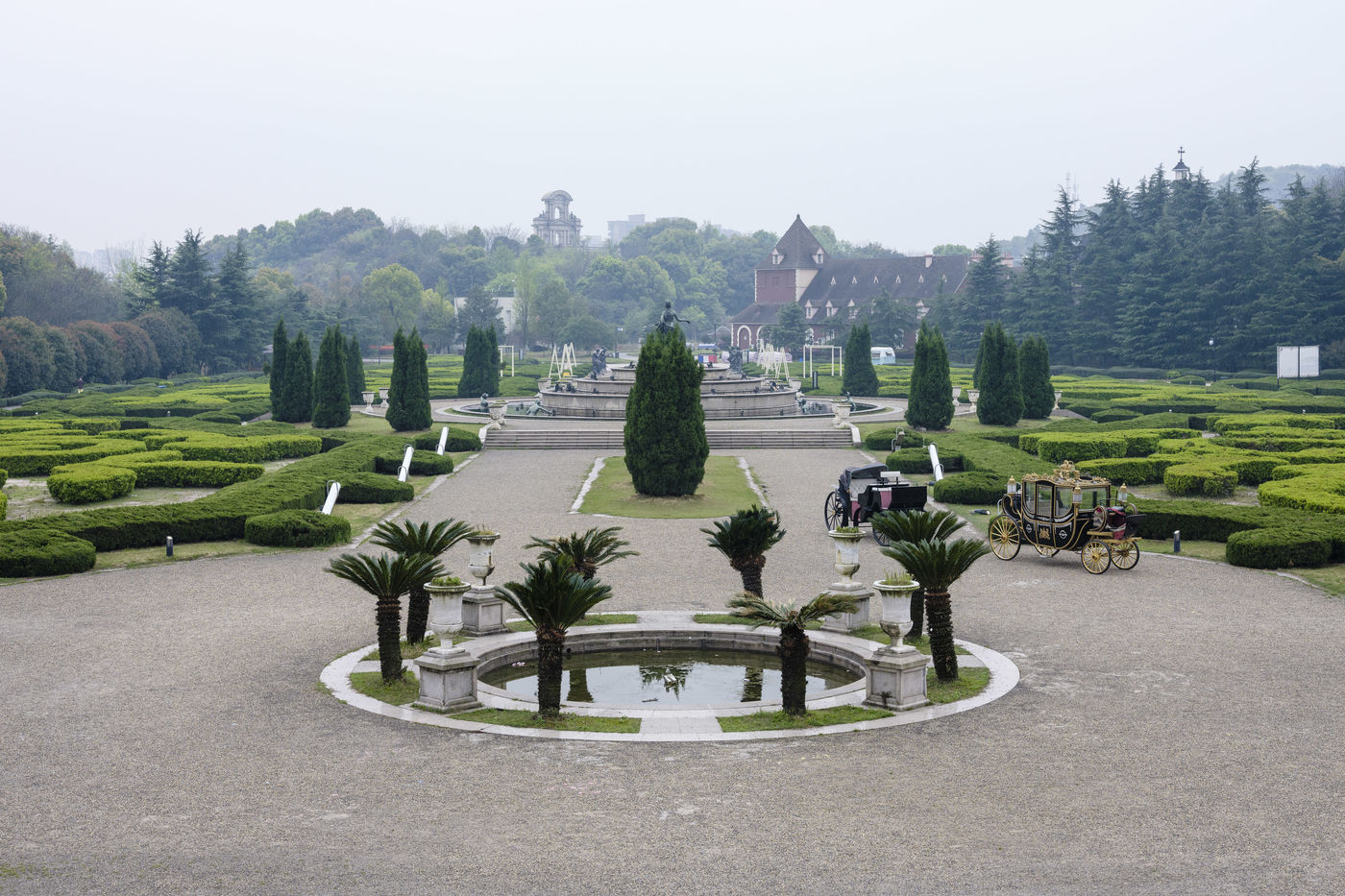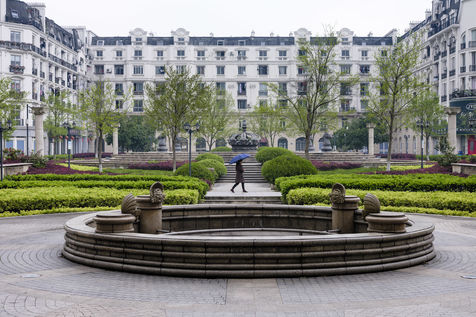Tiandu Cheng, un Paris réussi ?
Qui n'a pas entendu parler de Tiandu Cheng, ce « fake Paris » construit par l'entrepreneur chinois Guangsha ? À l'époque, en 2007, sa construction a fait couler beaucoup d'encre avec ses immeuble Haussmaniens, la réplique au 1/3 de la Tour Eiffel et son parc à la française emprunté au Château de Versailles. Évoquée de manière amusée, souvent condescendante, la ville avait heureusement le bon goût d'être un échec urbanistique cuisant, prouvant bien que Paris ne pouvait être imité et surtout que ces Chinois, malgré tout leur argent et leurs projets démesurés ne sauraient égaler l'art de vivre dans la Ville Lumière.
Il est vrai que 5 ans après la fin de sa construction, Tiandu Cheng ne comptait que 2000 habitants sur les 10 000 escomptés et qu'elle figurait sur la liste - longue - des villes fantôme chinoises.
Mais qu'en est-il aujourd'hui ?
Du fantasme à la réalité du terrain
Il a souvent été dit que Tiandu Cheng se voulait être un projet immobilier de luxe destiné à une classe supérieure qui, n'ayant ni les moyens suffisants ni le temps de voyager voulait rejoindre le niveau et la qualité de vie européens, tout du moins en rêve.
Or, c'était bien méconnaître la réalité du terrain.
Paris pour une clientèle de luxe ?
Tout d'abord, à l'époque de sa construction, les besoins en logements étaient aigus. Tiandu Cheng est située dans la banlieue de Hangzhou qui compte près de 10 millions d'habitants et une des villes les plus riches de Chine. De grands plans de renouvellement et de modernisation des logements du centre ville qui étaient insalubres - ou déclarés comme tels par les entrepreneurs privés qui n'hésitaient pas à jouer de la corruption - ont forcé des milliers de gens à se reloger ailleurs. C'est ainsi que nombre d'entre eux se sont vus attribuer à Tiandu Cheng 1, 2 voire 3 logements en fonction de la taille du foyer, en compensation de la perte de leur logement d'origine.
De cela découle deux choses. La première, c'est que la vacance des logements ne signifiait pas qu'ils n'avaient pas trouvé acquéreur, mais que ces derniers n'étaient tout simplement pas assez nombreux pour occuper tous les appartements dont ils étaient devenus propriétaires.
Par ailleurs, si plusieurs logements à la fois ont été attribués à un foyer en compensation d'un seul appartement, on peut aisément comprendre qu'ils coûtaient donc beaucoup moins cher que celui du centre-ville.
Tiandu Cheng n'a donc jamais été destinée à une clientèle de luxe et n'a donc jamais été vendue comme telle ! Car malgré leurs sculptures en façade, les prestations de ces appartements sont extrêmement basiques, ils sont petits avec maximum 70 m2 et les immeubles ne comportent même pas d'ascenseur. Sans compter le fait qu'à l'époque, Tiandu Cheng était perdue au milieu des champs dans une zone encore essentiellement rurale et où il n'était pas du tout chic d'aller vivre !
En Chine, rien de plus classique qu'un ensemble immobilier pour 10 000 habitants
On dit souvent qu'en Chine il faut tout multiplier par 10. Cet adage s'applique bien évidemment aux ensembles immobiliers qui fleurissent, encore aujourd'hui, à un rythme hallucinant ! Des logements pour 10 000 personnes, rien de plus classique dans le paysage urbain chinois. Ainsi, la partie « architecture parisienne » de ce quartier n'est qu'une petite part de ce qui est prévu car à terme il s'agira d'un quartier de 30 000 habitants ! La livraison des derniers appartements est prévu pour 2020. Bien entendu, il faut que les infrastructures suivent - routes, écoles, hôpitaux, transports, ...- et la création ex nihilo d'une ville de 30 000 habitants ne se fait pas du jour au lendemain. Mais en même temps que les derniers appartements seront livrés, le quartier se verra desservi par une nouvelle ligne de métro.
Derrière ce projet, la société Guangsha.
Contrairement à ce qui a souvent été écrit, cette cité n'est pas la lubie d'un milliardaire chinois mais le projet de la société immobilière Guangsha qui est l'une des plus importante en Chine. A-t-elle réussi à vendre tous ses appartements ?
Il semblerait que oui, en tous cas en ce qui concerne la partie « parisienne ». Ils ont tous été vendus et l'offre est inexistante. Et si aujourd'hui une majorité des occupants est locataire, c'est parce que les propriétaires ont depuis acheté des logements de meilleur standing et surtout plus spacieux dans les nouveaux immeubles avoisinants. En effet, d'après l'office de gestion des appartements, la partie parisienne souffre aujourd'hui d'un sérieux manque d'entretien et de nombreux bâtiments ont de graves problèmes d'infiltration d'eau ce qui fait qu'elle souffre d'une mauvaise réputation.
À l'inverse, l'autre partie de Tiandu Cheng, elle aussi construite par la société Guangsha rencontre elle beaucoup de succès. Là, pour acheter un appartement, il faut compter environ 20 000 rmb/m2, soit 2500 euro/m2. Quand on sait que le prix du mètre carré est deux, parfois trois fois plus cher dans le centre de Hangzhou, ce n'est pas étonnant que les habitants soient plutôt des primo acquéreurs ou des gens qui n'ont tout simplement pas les moyens d'accéder à la propriété dans des quartiers plus « huppés". Mais même en étant prêt à y mettre le prix, rien n'assure de pouvoir acheter. En effet, en Chine, face à la demande, il est courant de passer par la case « tirage au sort » pour déterminer qui, parmi tous les candidats, aura la chance de pouvoir réellement acheter le bien. Et à Tiandu Cheng, la chance est seulement entre 2 et 3 % selon la situation et l'immeuble.
La « duplitecture"
Bien entendu la question qui brûle les lèvres est de savoir si les habitants pensent qu'ils vivent réellement dans une réplique de Paris et si ce quartier attire vraiment les touristes chinois qui ne peuvent voyager. Comme il fallait s'y attendre, les gens ne sont pas dupes et pas un n'imagine que le vrai Paris ressemble à ce quartier, même s'ils n'y sont jamais allés. Hormis la Tour Eiffel qu'ils savent l'exacte réplique en plus petit de l'original, pas un ne pense que venir ici c'est comme visiter Paris.
Critiquée à cause de sa « copie » de l'architecture Haussmanienne par les médias occidentaux, ici en Chine on ne voit pas la réplication comme un problème mais plutôt comme une qualité, héritage du Confucianisme qui encourage l'élève à imiter le maître. De manière générale, il y a en Chine de nombreux cas de copies de monuments et de villes, ce que la journaliste Bianca Bosker appelle la « duplitecture », mot-valise qui mixe « duplication » et « architecture ». Mais elle n'est pas le seul apanage de la Chine et la ville de Las Vegas aux Etats-Unis est fameuse pour les répliques de monuments célèbres. Dans le même ordre d'idées, que penser alors des monuments directement inspirés de la Rome ou de la Grèce antiques à travers les pays occidentaux ?
À Tiandu Cheng il n'y a finalement que très peu de répliques exactes des originaux et ce sont surtout des statues ou des monuments qui sont pour la plupart dans le parc à proprement parler. Celui-ci a été dessiné dans le prolongement de la Tour Eiffel sous la forme de jardins à la française. Mais sa vocation est essentiellement pédagogique et chaque statue est accompagnée d'une pancarte explicative. Finalement, on pourrait même dire qu'il est dans le même esprit que le fameux Parc Oriental de Maulévrier dans le Maine et Loire qui reproduit un jardin japonais ainsi que des éléments architecturaux.
Un Paris touristique ?
Cependant, au contraire du parc de Maulévrier, celui de Tiandu Cheng est loin d'attirer les touristes en mal de voyages ! Il s'agit plus de promeneurs qui viennent des quartiers voisins, éventuellement de Hangzhou pour une sortie dominicale.
En fait, le seul vrai business qu'il semble y avoir, c'est celui des photos de mariage. Mais encore une fois, les couples ne viennent pas ici parce qu'ils ne peuvent pas voyager, mais simplement et surtout parce qu'aux yeux des Chinois, la France est le pays des amoureux. Rien ne peut être plus romantique que de poser devant la Tour Eiffel, le bassin d'Apollon ou dans le carrosse d'une Reine dans un jardin à la française ! Même s'il est difficile de comprendre pourquoi nous avons une telle réputation de romantiques - parce qu'en réalité il se trouve qu'au final les chinois le sont bien plus que nous - nous devrions plutôt être flattés et considérer que cette réputation est meilleure à prendre que bien d'autres !
Côté boutiques et commerces de la partie Haussmanienne, il sera difficile de trouver un seul magasin de souvenirs, même pas un porte-clé de Tour Eiffel ! Par contre, il est intéressant de constater qu'un nombre impressionnant de centres éducatifs pour enfants se sont installés, faisant de l'artère principale l'avenue des enfants. Des écoles de langues et de musique aux établissements artistiques ou d'apprentissages technologiques et de soutien scolaire, les parents n'ont que l'embarras du choix pour stimuler et surtout pour faire de leurs enfants ce qui est le « sport national » : des bêtes de concours.
Finalement, Tiandu Cheng n'est qu'un quartier - ou ville si l'on se réfère à l'échelle européenne - comme un autre dans le paysage urbain chinois d'aujourd'hui. Aujourd'hui c'est un quartier qui a pleinement pris son essor et la « ville fantôme » est très loin derrière. Sa seule spécificité est d'allier habitations et parc à thème, de manière d'ailleurs plutôt réussie car les gens trouvent qu'il fait bon y vivre. On est très loin d'une sorte de « parc Disney » où les habitants vivraient dans une « fake » ville pour le simple plaisir d'en jeter plein la vue ou pour simuler une vie d'ailleurs. Tout au plus lorsqu'on s'y promène on ressent une vague ressemblance, un "air de Paris », mais le quartier a toutes les spécificités chinoises, à commencer par les ventilateurs des climatiseurs sur les façades - indispensable dans le climat de Hangzhou - , le linge qui sèche aux fenêtres - impensable à Paris et encore moins dans un quartier Haussmanien ! - et sans oublier bien sûr les gens qui se promènent en pyjama - même pas en rêve à Paris !
Tiandu Cheng, a successful bet?
Who has not heard about Tiandu Cheng, this "fake Paris" built by the Chinese entrepreneur Guangsha? At that time, in 2007, its construction did a name of itself with its Haussmanian buildings, the 1/3 replica of the Eiffel Tower and its French-style park borrowed from the Château de Versailles. Amused and often condescending, the city fortunately had the good taste to be a stinging urban failure, proving that Paris could not be imitated and above all that these Chinese, despite all their money and their disproportionate projects, could not match the art of living in the City of Light.
It is true that 5 years after the end of its construction, Tiandu Cheng had only 2000 inhabitants out of the 10,000 expected and that it was on the - long - list of Chinese ghost towns.
But what about today?
From fantasy to reality on the ground
It has often been said that Tiandu Cheng was intended to be a luxury real estate project for a superior class who, without sufficient means or time to travel, wanted to reach the European standard of living and quality of life, at least in their dreams.
However, this was a misunderstanding of the reality on the ground.
Paris for a luxury clientele?
First of all, at the time of its construction, housing needs were acute. Tiandu Cheng is located in the suburbs of Hangzhou, which has a population of nearly 10 million and one of the richest cities in China. Major plans to renew and modernize housing in the city centre that were unhealthy - or declared as such by private entrepreneurs who did not hesitate to engage in corruption - forced thousands of people to relocate elsewhere. As a result, many of them were allocated 1, 2 or even 3 dwellings in Tiandu Cheng depending on the size of the household, as compensation for the loss of their original accommodation.
From this follows two things. The first is that the vacancies did not mean that they had not found a buyer, but that there were simply not enough of them to occupy all the apartments they had become owners.
Moreover, if several units at a time were allocated to a household as compensation for a single apartment, it is easy to understand that they were therefore much cheaper than the one in the city centre.
Tiandu Cheng was therefore never intended for a luxury clientele and was never sold as such! Because despite their sculptures on the facade, the services of these apartments are extremely basic, they are small with a maximum of 70 m2 and the buildings do not even have an elevator. Not to mention the fact that at the time, Tiandu Cheng was lost in the middle of the fields in an area that was still mainly rural and where it was not at all chic to go and live!
In China, nothing is more classic than a real estate complex per 10,000 inhabitants
It is often said that in China you have to multiply everything by 10. This adage obviously applies to real estate developments that are still flourishing at an incredible rate today! Housing for 10,000 people, nothing more traditional in the Chinese urban landscape. Thus, the "Parisian architecture" part of this district is only a small part of what is planned because in the long term it will be a district of 30,000 inhabitants! The delivery of the last apartments is scheduled for 2020. Of course, the infrastructure must follow - roads, schools, hospitals, transport, etc. - and the creation of a city of 30,000 inhabitants ex nihilo does not happen overnight. But at the same time as the last apartments will be delivered, the district will be served by a new metro line.
Behind this project, the company Guangsha.
Contrary to what has often been written, this city is not the whim of a Chinese billionaire but the project of the Guangsha real estate company which is one of the most important in China. Did she manage to sell all her apartments?
It would seem so, at least as far as the "Parisian" part is concerned. They have all been sold and the offer is non-existent. And if today a majority of the occupants are tenants, it is because the owners have since bought better quality and especially more spacious housing in the new neighboring buildings. Indeed, according to the apartment management office, the Parisian part suffers today from a serious lack of maintenance and many buildings have serious water infiltration problems, which means that it suffers from a bad reputation.
On the other hand, the other part of Tiandu Cheng, also built by the Guangsha company, is very successful. There, to buy an apartment, it's about 20,000 rmb/m2, or 2500 euro/m2. When we know that the price per square meter is two, sometimes three times higher in the centre of Hangzhou, it is not surprising that the inhabitants are rather first-time buyers or people who simply do not have the means to buy a home in more "upscale" neighborhoods. But even if you are willing to pay the price, there is no guarantee that you will be able to buy. Indeed, in China, faced with demand, it is common to go through the "draw" box to determine who, among all the candidates, will have the chance to actually buy the property. And in Tiandu Cheng, the odds are only between 2 and 3% depending on the situation and the building.
The "duplitecture"
Of course, the burning question is whether the inhabitants think they really live in a replica of Paris and whether this district really attracts Chinese tourists who cannot travel. As expected, people are not fooled and no one imagines that the real Paris looks like this district, even if they have never been there. Apart from the Eiffel Tower they know the exact smaller replica of the original, not one thinks that coming here is like visiting Paris.
Criticized for its "copy" of Haussmanian architecture by the Western media, in China replication is not seen as a problem but rather as a quality, a heritage of Confucianism that encourages the student to imitate the master. In general, there are many cases of copies of monuments and cities in China, what the journalist Bianca Bosker calls "duplitecture", a suitcase word that mixes "duplication" and "architecture". But it is not only in China and the city of Las Vegas in the United States is famous for replicas of famous monuments. In the same vein, what then should we think of monuments directly inspired by ancient Rome or Greece through Western countries?
In Tiandu Cheng there are finally only very few exact replicas of the originals and it is mainly statues or monuments that are mostly in the park itself. It was designed as an extension of the Eiffel Tower in the form of French gardens. But its vocation is essentially educational and each statue is accompanied by an explanatory sign. Finally, we could even say that it is in the same spirit as the famous Parc Oriental de Maulévrier in Maine et Loire, which reproduces a Japanese garden and architectural elements.
A touristic Paris?
However, unlike Maulévrier Park, Tiandu Cheng Park is far from attracting tourists in need of travel! It is more about walkers coming from the neighboring districts, possibly from Hangzhou for a Sunday outing.
In fact, the only real business there seems to be wedding photography. But once again, couples do not come here because they cannot travel, but simply and above all because, in the eyes of the Chinese, France is the land of lovers. Nothing could be more romantic than to pose in front of the Eiffel Tower, the Apollo basin or in a Queen's carriage in a French garden! Even if it is difficult to understand why we have such a reputation as romantics - because in reality it turns out that in the end the Chinese are much more so than we are - we should rather be flattered and consider that this reputation is better to take than many others!
As for the shops and businesses in the Haussmanian part, it will be difficult to find a single souvenir shop, not even a key ring of the Eiffel Tower! However, it is interesting to note that an impressive number of educational centres for children have been set up, making the main artery the children's avenue. From language and music schools to artistic or technological learning and tutoring institutions, parents have plenty of choice to stimulate and above all to make their children what is "national sport": competitors.
Finally, Tiandu Cheng is only a district - or city if we refer to the European scale - like any other in today's Chinese urban landscape. Today it is a district that has fully developed and the "ghost town" is far behind. Its only specificity is to combine housing and theme park, in a rather successful way because people find it pleasant to live there. This is a far cry from a kind of "Disney Park" where the inhabitants would live in a "fake" city for the simple pleasure of throwing it away or to simulate a life for that matter. At most when you walk around it you feel a vague resemblance, an "air of Paris", but the district has all the Chinese specificities, starting with the fans of the air conditioners on the facades - essential in the climate of Hangzhou -, the clothes drying in the windows - unthinkable in Paris and even less in a Haussmanian district! - and of course the people who wear pajamas - not even in dreams in Paris!

